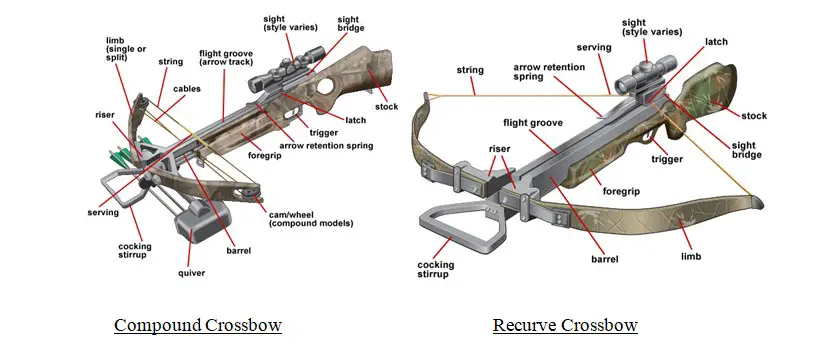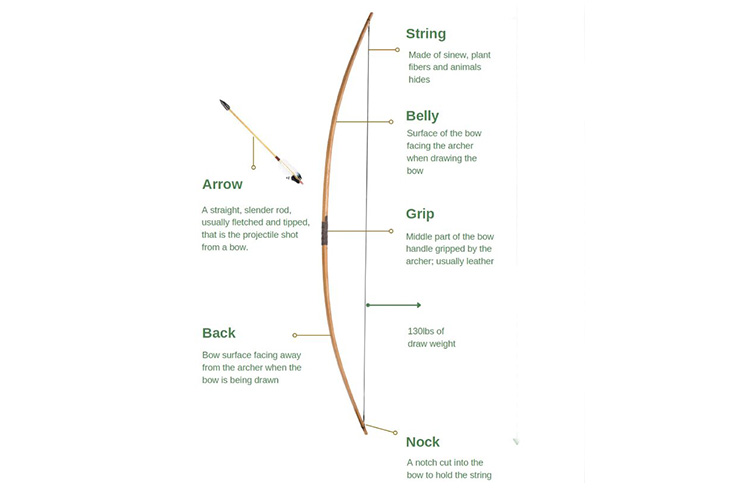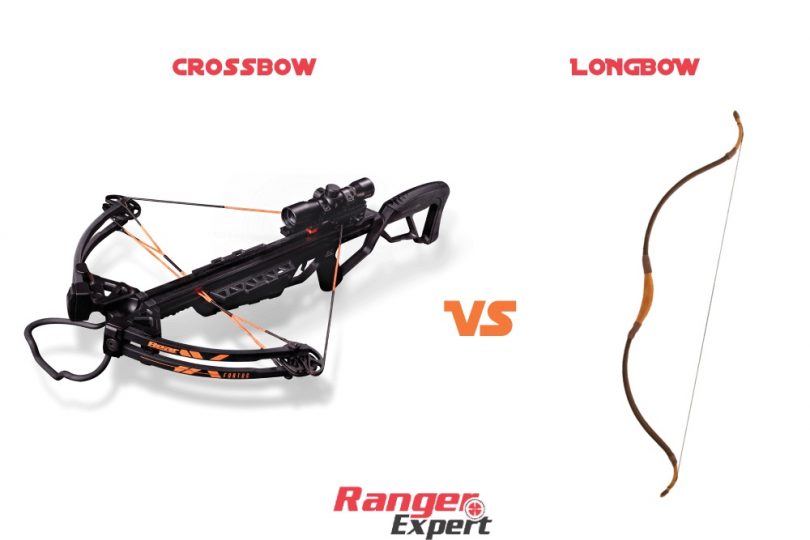Bows have been used for centuries. If you’re a beginning archer, you will want a bow that is easy to handle and aims well.
So, should you use a crossbow or a longbow? Does it even matter which one you use?
Let’s compare the two and see which one you’ll want to use to succeed as a toxophilite.
Crossbow vs Longbow
Training Needed
Crossbow
Crossbows are not for children. You should have lessons or take a course before using a crossbow.
It requires little effort to draw the string back, causing much less muscle fatigue.
You can preload a crossbow so you can shoot at a moment’s notice. If you can shoot a gun, you can use a crossbow.
Longbow
It takes longer to master the longbow.
When pulling the string back, the tension comes from your arm and shoulders; there is no mechanical mechanism to assist you
You can not preload a longbow; the bolts (arrow) must be shot one at a time
Bow Construction
Crossbow

A crossbow consists of a long frame (stock or tiller are commonly used names) with a bow mounted.
A built-in mechanism in the crossbow pulls the drawstring back when the trigger is pulled to release the bolt.
Longbow

A longbow is made of a long piece of wood (called a bowstave) curved; on each end is half-moon (letter D shaped).
A string is strung from one end to the other that’s used by pulling the bow back and letting the bolt fly.
Power and Intensity
Feet per second (FPS) measures the intensity or speed of arrows or bolts.
The power is measured in a foot-pound of kinetic energy (FPKE) that refers to the power the arrow is shot at per its weight.
For crossbow, it’s 350-400 FPS while for longbows, it ranges between 300 to 340 FPS.
How Far Can They Shoot?
A crossbow can cover 40 yards for a lethal shot and for longbows, it’s 200 yards.
Cocking the Bow
Crossbow
1. Hand cock
- Put the crossbow stirrup on the ground, step through the stirrup, holding the bow in place
- Grab the string on the side of the stock and place your thumbs alongside the barrel to guide the string
- Keep your arms straight, stand up, and exert even pressure on both sides. Then, pull the string back until it locks in place
2. Rope cock
- Put the stirrup on the ground
- Put your foot through the stirrup and hold it firm
- Guide the back of the strap over the butt of the crossbow
- Using the rope, attach the hooks to each side of the string
- Using the strap handles, stand until the string locks in place
Longbow
- Your feet should be shoulder-width apart, and your shoulders need to be angled slightly away from the target with your knees bent a bit to keep you balanced when shooting the longbow
- The bone in your hand’s web is where the bow’s grip will rest. Keep your fingers relaxed (too tight, and the shoot will be off)
- To draw the bow, place one finger over the arrow and two fingers under the arrow
- Pick a spot on your deer, bringing the bow up from your knees in one swift motion while keeping your eyes in the direction of the target
- Once you are comfortable with the bow’s placement and how far you have drawn back the bow, release the bow at the target point
Experience of the Hunter
An inexperienced hunter could practice with the crossbow for a few hours and use it safely.
On the other hand, a longbow should only be used by an experienced hunter or a beginner who has had longbow training.
Draw Weights
Crossbow: 75 to 150 pounds (150 pounds will kill a deer).
Longbow: 40 to 50 pounds (50 pounds will kill a deer).
Bolt Weight
Crossbow:
Weights vary by the bolt.
- 300 – 350 grains (lighter weight)
- 400 – 435 grains (regular or standard weight)
- 460 grains or more (heaviest weight)
Longbow:
The weight of the longbow arrow will depend on the size of the spine flex of the bow) you choose. Spines can be found in numbers like 350, 400, 500, etc.
The tip of the arrow (point weight) comes in a different material that will change the weight.
How long the bow is will affect the weight as well.
The fletching (arrow feathers ) will also factor into the weight.
Bolt Speed
Wind and weather conditions need to be factored in when gauging arrow speeds.
Crossbow:
The best FPS for your bolt depends on the weight of the bolt; the higher the grain, the slower the bolt.
Longbow:
For the best results, you want your arrow to be one inch shorter than your draw length (how far back you pull the string).
For example, if your draw weight is 30 inches, you want a 29-inch arrow.
It could take an arrow approx. One second to hit a target from 90 meters.
Ease of Carrying
The law requires you to transport the crossbow in a carrying case in most states. This is also the safest way to carry the crossbow.
The safest way to carry a longbow is on your back using a longbow sling.
Sound of the Bow
When shooting a crossbow, the sound is energy leaving the bow; using heavier arrows will quiet this noise.
Longbows make a twanging noise caused by the vibration; when a bow is out of tune, it gets louder. You can use dampeners or heavier arrows to minimize the sound.
Taking Care of Your Bow
Crossbow
- Wax the bowstrings and cables regularly
- Lubricate the rail every 50 – 60 shots
- Make sure to thoroughly dry all components if they get wet.
- Examine your crossbow every time you go hunting
Longbow
- Keep your longbow in a cool room
- Store it flat, back down, or hang it vertically with elastic bands or string around one end. Pushing on the string will distort it.
- Clean it with Danish oil if the bow gets soiled, scuffed, scratched, nicked, or dented.
- Wax the string with beeswax or string wax. Examine your string for damage and wear it every time you go out hunting.
Bow Safety
Crossbow
- Never walk with a cocked and loaded bow
- Never leave your crossbow cocked for a long time. It can cause a crack or break in the limb
- Keep your thumb clear of the rail; this lets you keep all your fingers
- Always seat your arrow properly to prevent it from dry firing
- Always use the correct nock for your bow. Using the wrong size nook can lead to injury and bow damage
- Lessons for first-time users are a must
- Limb clearance prevents misguided arrows and explosions
- Safely uncock your bow
- Inspect your crossbow to prevent accidents
- Inspect your strings; worn strings can be deadly
Longbow
- Point your bow only in the direction of the target
- Don’t nock until you are ready to hunt
- You should always be able to see where you are shooting; never send an arrow over the hill or at a tree
- Be aware of your surrounding, know where your target is, and the location of your hunting buddies
- Never dry-fire a bow; it may cause damage to the bow and can injure the archer
- Arrows should be used for hunting, do not be shot into the air
- Be respectful of other archers
- To avoid finger injuries, you may want to use a finger guard. An armguard will protect you from injury and give your wrist some added strength
- Arrows should be kept in your quiver until used. Maintain safety and be careful of those arrow points; they can lead to injury
- When stringing a longbow or recurve bow, a bow stringer can make the job quick and easy
- Always repair your equipment when you see the damage; waiting too long can lead to injury of the archer and worsen damage to your bow
- When storing the bow, remove the string and keep it in case that is sturdy to prevent bending of the bow
Crossbow Pros
- Easy to use once you have learned to hunt with a crossbow
- Accurate and versatile
- Powerful with a quick FPS that hits the game in no time
Crossbow Cons
- Crossbows are heavy, making it hard to aim for long and carry around.
- A Crossbow is noisy and slow to load, which can scare a deer when hunting.
Longbow Pros
- Easier to use when you are a beginner
- Bow releases easily
- Once you learn how to use it, you will shoot with precision
- If you are tall, this will be easy to handle; the bow length will not be an issue
Longbow Cons
- Hand Shock, the vibration of the bow after the arrow is released
- Not as mobile as a crossbow
- Arrow speed is slower than a crossbow
- Problems adjusting the bow and the arrow can be a problem
- Not all states allow you to hunt with a longbow
- Once you know how to use it, it is easy to shoot
Crossbow vs Longbow: Bow Hunting Weapon of Choice
If you are a seasoned hunter and are looking for a powerful gun with an accurate shot, the crossbow is the way to go.
While the crossbow is heavy and awkward to carry as you hunt, the ability to keep it cocked allows you to shoot as soon as you see your target.
Longbow hunters love the simplicity of the bow. Skilled archers can nock the bow easily and shoot (though slower than the crossbow).
They are quieter to load and shoot, much easier to carry due to being lightweight, cheaper than a crossbow, and simpler to maintain.
As a seasoned hunter, the bow of choice would be a crossbow for its accuracy and ease of aim.
Choosing your Bow
- Size of the bow you can handle
- How heavy a bow you can use
- How accurately you can shoot with the bow
- Ease of transporting and storing the bow
- Arrow speed and intensity
Crossbow vs Longbow: Different Hunting Situations
1. Tree stands
Crossbow
It is difficult to climb the standing stairs and carry the crossbow.
Of course, you will shoot more accurately, but reloading the bow may be difficult. The cocking and shooting of the crossbow are noisy.
Longbow
It is easier to get the longbow in the tree stand. Shooting the longbow from the stand is a bit tricky but the deer will have to be close to bag it.
2. Ground blinds
Crossbow
Using the crossbow in a ground blind makes shooting and reloading a piece of cake—no issues getting in and out of the blind.
Longbow
The longbow is easier to use in a ground blind.
You are closer to the game animal, and standing on solid ground makes keeping your balance while aiming a snap. Nocking the bow is much quicker on the ground.
3. On foot
Crossbow
A crossbow is heavy, awkward to carry, and can slow you down on foot. It can be kept loaded and cocked so you can shoot quicker.
It is loud when shot, possibly tipping off the game. A crossbow can go off while you are trekking through the woods on foot.
Longbow
The longbow is easier to carry and is lightweight; you will not get tired from carrying it.
Nocking it is quick and easy with experience (the crossbow is slower to load).
Accuracy is equal to a crossbow for the expert longbowman. There is no fear of an accident with the longbow while trekking in the woods.
Hunting Seasons & State Laws
In many states, bow season starts when archery season begins. This gives you a longer timeframe to use your bow.
Warmer weather offers a variety of bow use. Not all states allow you to use a longbow!
You can hunt in warmer weather when the deer are not as skittish. During bow hunting season, you are only competing with other bowhunters.
Not all states allow you to hunt with a longbow!
Check your state’s hunting regulations before you go hunting. Make sure you have the proper license and keep it with you while you hunt.









Leave a Comment